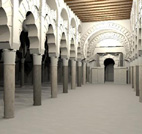|
|
[FBG02]
Cornell University Program of Computer Graphics |
|
||||
Local illumination environments for direct lighting acceleration.Sebastian Fernandez, Kavita Bala, and Donald P. Greenberg.In P. Debevec and S. Gibson, editors, Eurographics Workshop on Rendering. Springer-Verlag, 2002. Computing high-quality direct illumination in scenes with many lights is an open area of research. This paper presents a world-space caching mechanism called local illumination environments that enables interactive direct illumination in complex scenes on a cluster of off-the-shelf PCs. A local illumination environment (LIE) caches geometric and radiometric information related to direct illumination. A LIE is associated with every octree cell constructed over the scene. Each LIE stores a set of visible lights, with associated occluders (if they exist). LIEs are effective at accelerating direct illumination because they both eliminate shadow rays for fully visible and fully occluded regions of the scene, and decrease the cost of shadow rays in other regions. Shadow ray computation for the partially occluded regions is accelerated using the cached potential occluders. One important implication of storing occluders is that rendering is accelerated while producing accurate hard and soft shadows. This paper also describes a simple perceptual metric based on Weber's law that further improves the effectiveness of LIEs in the fully visible and partially occluded regions. LIE construction is view-driven, continuously refined, and asynchronous with the shading process. In complex scenes of hundreds of thousands of polygons with up to a hundred lights, the LIEs improve rendering performance by 10x to 30x over a traditional ray tracer.
This paper is available as a PDF file FBG02.pdf (766K).
| ||||||
| ||||||
